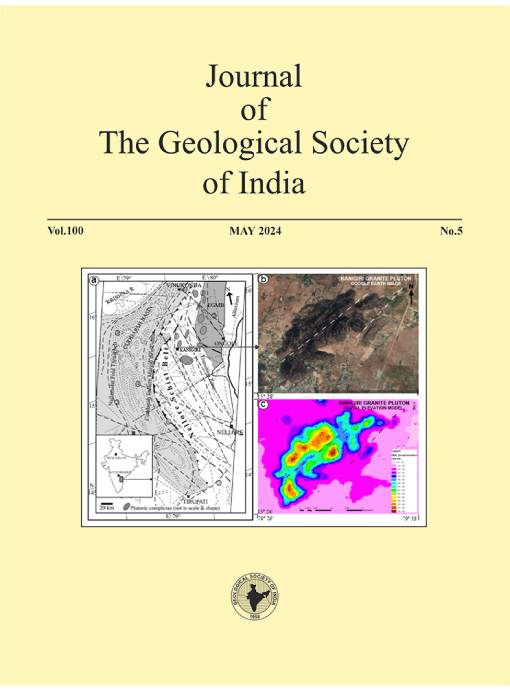Mineral Chemistry and IMA Nomenclature of Amphibole Minerals of Amphibolite Sills from Chhotanagpur Granite Gneiss Complex (CGGC), Southern Sonbhadra, Central India
DOI:
https://doi.org/10.17491/jgsi/2024/173890Keywords:
No Keywords.Abstract
In southern part of Sonbhadra District, near the Rihand Dam, low to medium grade amphibolites of Paleoproterozoic age are exposed. The outcrops are in the form of sills that occur at places in the Chhotanagpur Granite Gneiss Complex (CGGC). The essential mineralogical constituents of the amphibolite are amphibole-plagioclase-chlorite-biotite-iron oxides. Based on the mineral chemistry and interpretation as per the international mineralogical association (IMA) nomenclature scheme, amphiboles in the analysed amphibolite rock samples have been identified as magnesio-hornblende, magnesio-ferrihornblende and edenite.
Downloads
Metrics
Issue
Section
Downloads
Published
How to Cite
References
Acharya, S.K. and Roy, A. (2000) Tectonothermal history of the Central Indian Tectonic Zone and reactivation of major fault/shear zones. Jour. Geol. Soc. India, v.55, pp.239-256.
Andrew J. Locock (2014) An excel spreadsheet to classify chemical analyses of amphiboles following the IMA 2012 recommendations Comp. Geosci., v.62 pp.1-11.
Deer, W.A., Howie, R.A. and Zussman, J. (2013) An Introduction to the Rock-Forming Minerals (3rd ed.). Longman Group UK Limited, Essex, U.K.
DeVore, G.W. (1955) Crystal growth and the distribution of elements. Jour. Geol., v,63 pp.471-494.
Fosile, S. (1974) Hastingstes and amphiboles from the epidote-amphibolite facies. Norsk. Geol. Tidsskr., v.25, pp.74.
Harry, W. T. (1950) Aluminum replacing silicon in some silicate lattices. Mineral. Mag. v.29 pp.142-149.
Hietanen, A. (1974) Amphibole pairs, epidote minerals, chlorite, and plagioclase in metamorphic rocks, northern Sierra Nevada, California. American Mineralogist: Jour. Earth Planet. Mater., v.59(1-2), pp. 22-40.
Jain, S.C., Nair, K.K.K. and Yedekar, D.B. (1995) Geology of the Son-Narmada-Tapti Lineament zone in Central India. Project CRUMANSONATA. Geol. Surv. India Spec Publ. No.10, pp.1-154.
Leake, B.E., Woolley, A.R., Arps, C.E., Birch, W.D., Gilbert, M.C., Grice, J.D., Hawthorne, F.C., Kato, A., Kisch, H.J., Krivovichev, V.G., Linthout, K., Laird, J., Mandarino, J.A., Maresch, W.V., Nickel, E.H., Rock, N.M.S., Schumacher, J.C., Smith, D.C., Stephenson, N.C.N., Ungaretti, L., Whittaker, E. J. W. and Youzhi, G. (1997) Nomenclature of amphiboles; report of the subcommittee on amphiboles of the International Mineralogical Association, Commission on New Minerals and Mineral Names. Canadian Mineral, v.35(1), pp.219-246.
Leake, B.E., Woolley, A.R., Birch, W.D., Burke, E. A., Ferraris, G., Grice, J.D., Hawthorne, F.C., Kisch, H.J., Krivovichev, V. G., Schumacher, J.C., Stephenson, N.C.N. and Whittaker, E.J. (2004) Nomenclature of amphiboles: additions and revisions to the International Mineralogical Association’s amphibole nomenclature. Mineral. Magz., v.68(1), pp.209-215.
Raase, P. (1974) Al and Ti content of hornblende indicators of pressure and temperature of regional metamorphism. Contrib. Mineral. Petrol., v.45 pp.231-23
Ramberg, H. (1952) The origin of metamorphic and metasomatic rocks. Univ. Chicago Press, Chicago. 352p.
Roy, A. and Bandyopadhyay and B.K. (1988) Tectonic Significance of Ultramafic and Associated Rocks Near Tal in the Bijawar Belt, Sidhi District, Madhya Pradesh. Jour. Geol. Soc. India, v.32(5), pp.397-410.
Roy, A. and Bandyopadhyay, B.K. (1990) Tectonic and structural pattern of the Mahakoshal belt of Central India. A discussion. In: Precambrian of Central India. Geol. Surv. India, Spl. Publ. v.28, pp.226–340.
Shido, F. (1958) Plutonic and metamorphic rocks of the Nokoso and Irituno districts in the central Abukuma Plateau. Jour. Fac. Sci. Uni., Tokyo, v.11 pp.131-217.
Singh, Ankita, A., Singh, B.P., Prakash, D. and Singh, C.K. (2023) Unravelling Source Area Composition for the Paleoproterozoic Basal Conglomerate (Vindhyan Supergroup) around Dalla, Sonbhadra District, Central India. Jour. Geol. Soc. India, v.99, pp.187-192.
Singh, C.K. (2014) Active Deformations Extracted from Drainage Geomorphology: A Case Study from Southern Sonbhadra District, Central India. Jour. Geol. Soc. India., v.84, pp.569-578.
Singh, C.K. and Srivastava, V. (2011) Morphotectonics of the Area Around Renukoot, District Sonbhadra, U.P. using Remote Sensing and GIS Techniques. Jour. Indian Soc. Rem. Sens., v.39, pp.235- 240.

 Ankita A. Singh
Ankita A. Singh






